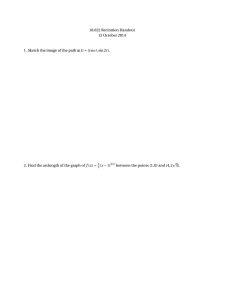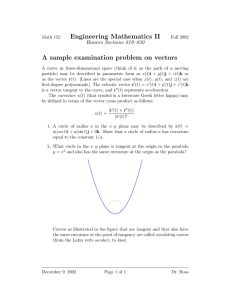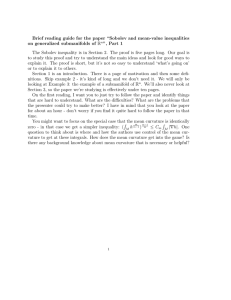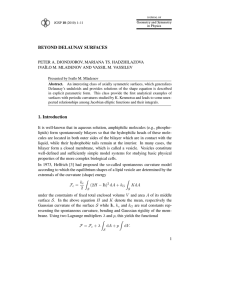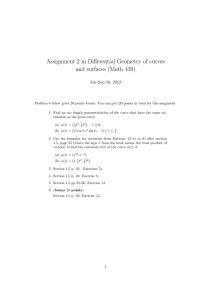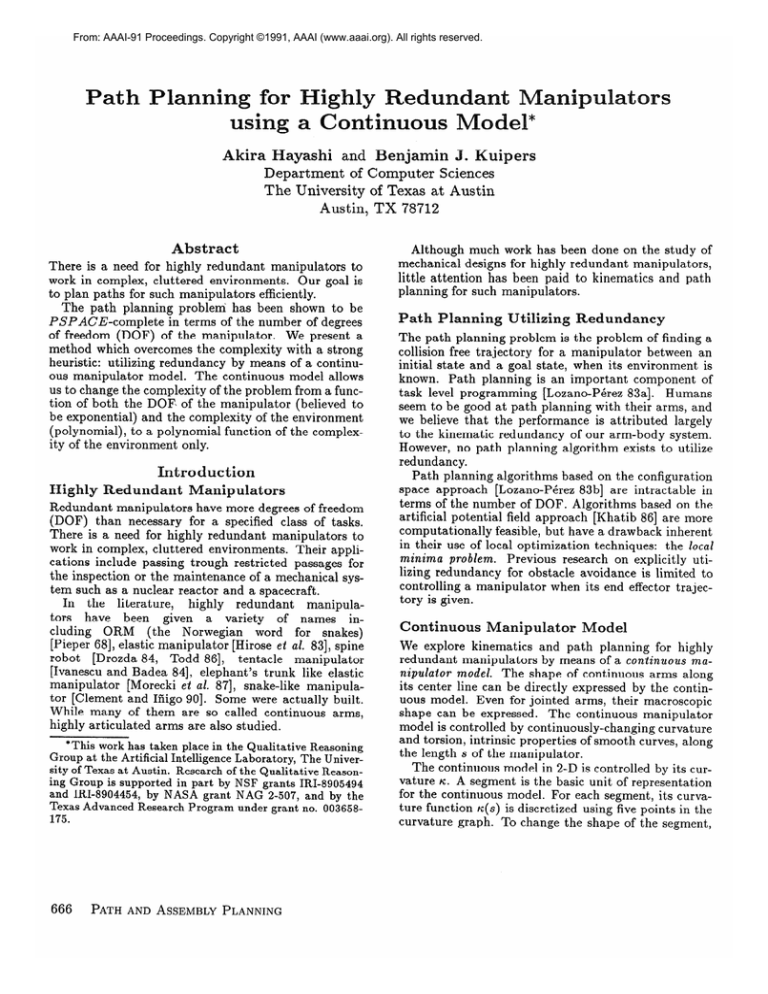
From: AAAI-91 Proceedings. Copyright ©1991, AAAI (www.aaai.org). All rights reserved.
Path
Planning
for
using a Continuous
Akira
Hayashi
Department
and
of Computer
The University
Austin,
Abstract
There is a need for highly redundant
manipulators
to
work in complex, cluttered environments.
Our goal is
to plan paths for such manipulators
efficiently.
The path planning problem‘ has been shown to be
PSPACE-complete
in terms of the number of degrees
of freedom (DOF) of the manipulator.
We present a
method which overcomes the complexity with a strong
heuristic:
utilizing redundancy
by means of a continuous manipulator
model. The continuous model allows
us to change the complexity of the problem from a function of both the DOF\ of the manipulator
(believed to
be exponential)
and the complexity of the environment
(polynomial),
to a polynomial function of the complexity of the environment
only.
Introduction
Highly
Redundant
Manipulators
Redundant manipulators
have more degrees of freedom
(DOF)
than necessary
for a specified class of tasks.
There is a need for highly redundant manipulators
to
work in complex, cluttered environments.
Their applications include passing trough restricted
passages for
the inspection or the maintenance
of a mechanical system such as a nuclear reactor and a spacecraft.
In the
literature,
highly
redundant
manipulators
have
been
given
a variety
of names
including
ORM
(the
Norwegian
word for snakes)
[Pieper 681, elastic manipulator
[Hirose et al. 831, spine
robot
[Drozda 84, Todd 861, tentacle
manipulator
[Ivanescu and Badea 841, elephant’s
trunk like elastic
manipulator
[Morecki et al. 871, snake-like
manipulator [Clement and Ifiigo 901. Some were actually built.
While many of them are so called continuous
arms,
highly articulated
arms are also studied.
*This work has taken place in the Qualitative Reasoning
Group at the Artificial Intelligence Laboratory, The University of Texas at Austin. Research of the Qualitative
Reasoning Group is supported in part by NSF grants IRI-8905494
and IRI-8904454,
by NASA grant NAG 2-507, and by the
Texas Advanced Research Program under grant no. 003658175.
666
PATH
AND
ASSEMBLY
PLANNING
Benjamin
of Texas
TX
J. Kuipers
Sciences
at Austin
78712
Although much work has been done on the study of
mechanical designs for highly redundant manipulators,
little attention
has been paid to kinematics
and path
planning for such manipulators.
Path
Planning
Utilizing
Redundancy
The path planning problem is the problem of finding a
collision free trajectory
for a manipulator
between an
initial state and a goal state, when its environment
is
known. Path planning is an important
component
of
task level programming
[Lozano-Perez
83a].
Humans
seem to be good at path planning with their arms, and
we believe that the performance
is attributed
largely
to the kinematic redundancy
of our arm-body
system.
However, no path planning algorithm
exists to utilize
redundancy.
Path planning algorithms based on the configuration
space approach [Lozano-P&ez
83b] are intractable
in
terms of the number of DOF. Algorithms
based on the
artificial potential field approach [Khatib 861 are more
computationally
feasible, but have a drawback inherent
in their use of local optimization
techniques:
the locad
minima problem.
Previous research on explicitly utilizing redundancy
for obstacle avoidance is limited to
controlling a manipulator
when its end effector trajectory is given.
Continuous
Manipulator
Model
We explore kinematics
and path planning for highly
redundant manipulators
by means of a continuous manipulator model. The shape of continuous arms along
its center line can be directly expressed by the continuous model. Even for jointed arms, their macroscopic
shape can be expressed.
The continuous manipulator
model is controlled by continuously-changing
curvature
and torsion, intrinsic properties of smooth curves, along
the length s of the manipulator.
The continuous model in 2-D is controlled by its curvature K. A segment is the basic unit of representation
for the continuous model. For each segment, its curvature function K(S) is discretized using five points in the
curvature graph. To change the shape of the segment,
--I Seg3
d&&
.*
.a
sega
*-.
*.
2
Segl
(configuration)
(curvature)
(configuration)
Figure
1:
ators. The
curvature
ncc, nd, or
the base.
Figure
Curvature Segment Representation
and its Operfollowing curvature
opemtors
are used to change
(and configuration).
a. Increase/decrease
&, Kb,
9b, a=, or 8d. c. Rotate
ne. b. I ncrease/decrease
curvature operators are defined to move the points. See
Fig. 1.
The continuous
model in 3-D is controlled by both
curvature K and torsion r. For each segment, its torsion function ~(5) is also discretized
using five points
(SG&
and (se,c>.
Opera(&z,cz), (sa,n),
( sc,~,),
tors now include those to move (So, TV) through (se, 7,).
We use the Frenet equations (1) to obtain a configuration from curvature and torsion (see [Stoker 691).
($[!8)
= (
-+4
TV;
+$
)
(3j
)
(1)
v 3( s > are the tangent,
normal,
and binorv2(4,
ma1 vectors.
After we obtain vi(s) by integrating
(1)
numerically, the configuration
I?(s) = (X(S), y(s), z(s))~
is obtained using
Q(S),
s
P(s)
=lp(so)+
J
SO
to Path
of Segment
cluttered space. Second, we plan a smooth trajectory
through free space for the end eflector with a maximum
curvature constraint,
by searching a connectivity
graph
of primary convex regions. Third, the trajectory
generates a set of position subgoals for the continuous manipulator which are achieved by the basic motion schemas.
Fourth, the mapping from the continuous model to the
available jointed arm provides the curvature bound and
obstacle envelopes required (in step 2) to guarantee a
collision-free path.
[Chirikjian and Burdick 901 presents
an approach
similar to ours. While we use 5 point interpolation
to
discretize curvature and torsion, they use a modal deHowever, in their paper, obstacle avoidcomposition.
ance was accomplished
by manual decomposition
and
selection of curvature functions.
Also, the problem of
bounding the error in the mapping from the continuous
model to the jointed arm is not addressed.
Schemas
Hill-climb:
Hill climbing search to achieve tip position/orientation
or end curvature/torsion.
The curvature/torsion
operators are used as next-state
functions.
Interpolate:
Move by interpolation
ified curvature/torsion
profiles.
must be the
Fold/Unfold:
to a segment,
entation.
Open
Planning
First, we develop motion schemas for the individual
segments to achieve a basic set of goals in open and
between
two spec-
Feed/Retract:
Increase
(decrease)
the length allocated to a segment
by moving the tip along a
trajectory
to reach a given position/orientation.
This is a motion schema to represent
the followthe-leader
type,
snake-like
motion
considered
in
[Clement and Inigo 901.
must be continu-
Because of the continuity of our model, we have great
flexibility
in decompositions.
In particular,
we can
choose any point as a decomposition
point, and we can
move a decomposition
point smoothly along the length
of the continuous
model to make one segment longer
while making the other shorter.
Our Approach
2: Decomposition
Following is the list of basic motion schemas for an individual segment to achieve a basic set of goals in open
and cluttered space.
The number of segments is controlled
by a decomposition technique
to dynamically
change the degree
of redundancy.
The decomposition
technique makes it
possible to divide a segment into two or more segments
(Fig. 2). For a decomposition
to be meaningful, we have
the following decomposition
rules;
e Curvature/torsion
and orientation
ous at a decomposition
point.
Seg3
(curvature)
asic Motion
vl(+g
e The total length of segments generated
same as that of the original segment.
Seg2 '
Segl
..
...'
’
Increase (decrease)
while maintaining
the length allocated
tip position and ori-
Space
Hit&climb and Interpolate schemas are used to achieve
The naive hill
position/orientation
in open space.
HAYASHI
& KUIPERS
667
Figure
3: Successful Hill-Climbing.
This and subsequent
figures show graphical output from our simulator.
Each display shows multiple plots of (x(s), y(s)) on the left and K(S)
on the right for a finite sequence of times to,. . . , t,.
The
arrow in the figure shows the goal position and its orienta-
Figure
6: (Top)
Interpolate
and (Bottom)
Hill Climb:
move by interpolation
from the initial state to the instance
nearest to the goal, then hill climb to the goal.
0
1
@t!-
Figure
4: Local
Minimum
in Hill Climbing
climbing search works when its initial state is close to a
goal state (Fig. 3), but does not work in the example in
Fig. 4. To eliminate the problem, we add a capability of
selecting and interpolating
to a good initial configuration before hill-climbing search (Fig. 6). Five curvature
segment types in Fig. 5 are used as candidates for good
initial configurations
in 2-D.
Cluttered
Space
We assume there is enough open space around the base
to fold the manipulator.
To achieve a position in cluttered space, the continuous
manipulator
is retracted,
rotated, and then extended.
Once subgoals along a path
are obtained, segments are added one by one at the tip
to achieve each of the subgoals.
Feed schema is used
with the tip segment to achieve a subgoal, while Unfold
schema is used with the segment folded as a circular arc
to provide the length to Feed the tip segment along a
trajectory
(see Fig. 7). The trajectories
between subgoals are cubic spiral curves which will be explained
shortly.
/>cFy
type
0
type
Figure
668
PATH
1
type
2
type
5: Curvature Segment
AND ASSEMBLY
PLANNING
3
Type
type
4
Figure
7: Achieving
Subgoals
along
a path
-__-__
1-l---~ggq
IIIII
i--cc
IIII
--- i-111
/_I(ll ill
---- r-l
I---I!-!
__
Figure
Planning
(4
8: Wall segments and PCRs
Decomposition
Free space is decomposed
into primary convex regions
[Rueb and Wong $71. A primary convex region (PCR)
is an unobstructed
convex region with each boundary
edge covering some portion of an obstacle wall. See
Fig. 8. In the figure, each region is shrunk only for visibility. PCRs are found efficiently by a directed search
for a set of fundamental
circuits in an abstract graphical
representation
of the environment
geometry.
Making
a Smooth
Turn between
PC
We need to locate turning corners appropriately,
both
to make a smooth turn from one PCR to another while
satisfying the maximum
curvature constraint,
and to
find a shorter path to reach a goal. For a small overlapping region, we use its center of gravity as a turning
corner.
A large overlapping region can be further divided around its center of gravity in order not to miss
smooth turns.
[Kanayama and Hartman 891 presents a method to
make a smooth move from one position and orientation
to another, using cubic spiral curves. We use cubic spirals to provide a continuous curvature path, since they
can be constructed
to have zero curvature at tangent
points. A cubic spiral is a curve whose orientation
(integration of curvature) is described by a cubic function
of path distance s.
Proposition
1 (Kanayarna and Wartman)
size d and the deflection
cy of a cubic
spiral
where
9a), its length d and curvature
I
=
d
w-4
K(S)
=
6ay3
s E [-$,
+$I
6 are
(2)
- g>
(($2
and D(a)
If
the
is given
(3)
= 2Jo 1’2 cos(a(3/2
-
2s2)s)ds.
This result is directly applicable to making a smooth
turn. For each candidate corner, we check whether we
can make a turn as follows.
1. Find dnain, the minimum d consistent
imum curvature constraint.
to PCRs
(b) d;f,‘,“,”
&&
(Fig.
a Smooth
Robot
We present an algorithm
to find a smooth path (i.e.
a continuous curvature path) under a maximum curvature constraint for a point robot. An end effector trajectory for the continuous manipulator
is obtained by the
algorithm.
Our algorithm
first decomposes
free space
into convex regions. Then, smooth paths are found by
extending previous algorithms
to find polygonal paths
regions of the conin the convex regions. Overlapping
vex regions are used to make smooth turns from one
region to another.
Free Space
9: (a) S mooth Turn using a Cubic Spiral
Figure
the maximum
2. Find dciz,
entirely within free space.
with the max-
d for which the curve lies
the maximum d for a cubic
3. Find dc:,,
along both tangent line segments.
spiral to fit
4. Check dmin 5 min(d~~$
dEi,).
This
that we can make a collision free turn
maximum curvature.
guarantees
within the
In order to find dmin, note
its maximum
at the midpoint.
1.5cYD(cY)
~max
that K(S) in (3) has
Hence, d 2 dnin =
To find cl%::, we notice that a cubic spirals is always
contained in the area outlined by its tangent lines and
the circular arc which is tangent at the same points.
To find a tangent arc which is both collision free and
has the maximal radius r,,,,
we apply the condition
that the arc passes through one of the corners of the
overlapping region (Fig. 9b). From this, we obtain d 5
dgiz = 2r rrm,~~7+/2).
It is possible to find whether we can fit smooth turns
by using d,i,
and d$fz obtained, given a whole candidate polygonal path. However, this leads to an exhaustive search. We use a local fit method instead.
When
making a turn, we confine its starting and ending points
within the distance of lmin = min(Zl/2,12/2)
from the
turning corner, where II (a,) is the length of a incoming (outgoing)
line segment (Fig. 9c). To make a turn
within lmin, we require that d 5 dc6, = 2Z,~,cos(a/2).
HAYASHI
&
Kr JIPERS
669
Graph
Search
We now build a connectivity
graph and search for a
path which satisfies the maximum curvature constraint.
Nodes in the connectivity
graph represent the straight
line segments within PCRs. An edge from a node Ni to
Nj exists if and only if the corresponding
line segments
Li and Lj share an end point and there is a smooth turn
from Li to Lj. We use the A* algorithm to find a path
in the connectivity
graph. As a heuristic function, we
use Euclidean distance from a current node (midpoint
of its line segment) to a goal position.
Fig. 10 shows
the steps involved in the path planning.
Fig. 11 shows
the paths found.
(1)
(2)
Complexity
A loose upper bound on the complexity
of our algorithm is obtained as follows. An upper bound on the
algorithm to find PCRs [Rueb and Wong 873 is O(n4)
time in the number of obstacle edges. If we treat the
number of candidate turning corners as a constant, the
number of nodes for A* search is bounded by 0( n12).
This is because there cannot be more than O(n4) PCRs
and a node in the graph is determined
by a sequence
of 3 PCRs.
By using the algorithm in [Martelli 771 to
improve the exponential
worst case running time of A*,
we obtain O(n24) as an upper bound.
The algorithm is quite efficient in practice. Rueb and
Wong have also reported an O(n) performance result for
as opposed to the O(n4> upper bound.
his experiment
This immediately
makes our algorithm
run in O(n6)
time instead of O(n24). F ur th ermore, average case running time for A* search is much better because of the
heuristic associated.
In fact, the four paths shown in
Fig. 11 were found in 11, 18, and 119 seconds respectively on a Symbolics 3670 without floating point hardware.
Finding
Subgoals
I
(4)
I
(5)
(6)
Figure 10: Steps Involved in Path Planning.
(1) Initial
and goal position is given. (2) Identify PCRs.
(only those
on the solution
path are shown.)
(3) Identify candidate
turning points in overlap regions.
(4) Find least cost path
in connectivity
graph, consistent
with maximum
curvature
constraint.
(5) Create smooth path by inserting cubic spirals. (6) Identify subgoals
as start/end
points of turns of
the path.
for Manipulator
First, locate the folded manipulator.
The primary convex region which contains
the folded manipulator
is
called the base PCR. When we fold the manipulator
as
a circular
arc, we can extend the manipulator
from anywhere on the circle by rotating
around the base. Hence,
as initial states of the graph search, we use tangent lines
to the circle from all candidate turning corners in the
overlaps with the base PCR. These initial states naturally correspond
to partial paths through which we
can extend the manipulator.
After defining the initial
states, graph search proceeds exactly in the same manner to generate
the position
subgoals
in Fig. 7. The
modification does not change the complexity of the original algorithm to find smooth paths.
670
PATH
AND
ASSEMBLY
PLANNING
Figure
11: Paths Found. Inner circles at the bottom right
have the maximum
curvature given for searches, and outer
circles have maximum curvature for the paths found (radius
is the inverse of curvature).
In these examples,
only the
centers of gravity of overlaps are used as candidate
turning
Figure
Frames
12: Jointed Arm Trajectory.
2,4,6of Fig. 7 are shown here.
Extend
Only
mappings
of
Figure 13: (Left) Single arc case: both ends of the link pair
(Right) Tangent arcs case:
are on the same cubic spiral.
both ends are on consecutive
cubic spirals with opposite sign
of curvature.
Tangent arcs with the same curvature sign is
similar to the single arc case and is less critical.
to 3-D
Two approaches
are feasible for path planning in 3-D
space.
[Brooks 83a] proposed decomposing
free space into
generalized
cones in order to find a path for mobile
robots.
The same free space representation
was then
used to plan a collision free path for manipulators
by
restricting the hand movement [Brooks 83b]. Free space
in 3-D is represented by its horizontal 2-D slices. With
this 21-D approach, most of the method we have explaine Fi can be used without modification.
Alternatively,
we decompose 3-D free space into primary convex regions.
Smooth
3-D curves with curvature and torsion will be used in lieu of cubic spirals to make turns from one such region to another.
We (see [Hayashi 911) h ave extended the algorithm in
[Singh and Wagh $71 to find primary convex regions in
2-D. Their algorithm requires that obstacles be approximated by iso-oriented rectangles.
Figure
14: Relative
Error
for Tangent
Arcs
Case
as Func-
we enumerate pairs of tangent cubic spiral arcs
ous turning angles cx to obtain the error bound.
shows a graph for the errors obtained for the
tangent arcs cases as a function of cy, given the
ing three maximum curvature constraints.
of variFig. 14
critical
follow-
1
Mapping
to a Jointed
Arm
We provide a mapping to a jointed arm which has an
even number of links of the same length. First, group
links into pairs of consecutive
links. Then, place odd
numbered joints (1,3, . . .) on the continuous solution in
such a way that they are equi-distant.
The positions
of even numbered joints (2,4,. . .) are automatically
determined in the process.
Using this every-other-joint
mapping, the trajectory
for the continuous manipulator
in Fig. 7 is mapped to
a trajectory
for an arm with 12 joints in Fig. 12.
The mapping error is evaluated as follows. Since the
every-other-joint
mapping is a local mapping scheme,
only the mapping for two consecutive
links has to be
considered.
Furthermore,
if we assume the following,
only two cases, a single arc case and a tangent arcs
case, are left in terms of errors (Fig. 13).
Each cubic spiral segment (including the straight
line segments at both ends, if they exist) is longer
than 2 * I, where I is the length of each link of the
jointed arm.
In order to evaluate the single arc case, we use a circular arc whose curvature is equal to the maximum curvature of the cubic spiral. This gives us an upper bound
on the error. In order to evaluate the tangent arcs case,
(4
The relative error is plotted.
Each error function decreases in a rage of o where the maximum curvature
constraint
becomes relevant to the error analysis. The
maximum value for the error functions increases with
Kmax:, the maximum curvature constraint.
As seen in
the graph, the relative error does not exceed 22% for
Kmax =n*
1
The tangent arcs case has larger errors than the single
arc case, and we summarize the results as follows.
Proposition
2 Let I be the length of each link. The
error of the every-other-joint
mapping does not exceed
0.22 * d, if the following conditions are satisfied.
(1) Each cubic spiral segment is longer than 2 * 1.
(2,) The maximum curvature of cubic spiral segments is
below I/l.
In fact, the path shown in Fig. 7 was obtained by first
growing the obstacles in Fig. 12 by 0.22 * I and then
planning a path for the continuous
manipulator
with
the above two conditions.
The proposition
guarantees
that the mapping back to a path for the jointed arm
will yield a collision free path.
HAYASHI
& KUIPERS
671
Gonclusions
have presented a path planning method for highly
redundant
manipulators
by means of a continuous
model, which captures a macroscopic
shape of highly
redundant manipulators.
The path planning problem has been shown to be
PSPACE-complete
in terms of DOF of the manipulator [Reif 79, Canny 881. Our approach overcomes
the complexity with a strong heuristic: utilizing redundancy by means of the continuous model. The continuous model allows us to change the complexity
of the
planning problem from a function of both the DOF of
the manipulator
(believed to be exponential)
and the
complexity of the environment
(polynomial),
to a polynomial function of the complexity
of the environment
only.
DOF of the manipulator
is a resource to be utilized in
our approach, because the error bound on the mapping
improves with the number of DOF of the manipulator.
Essentially,
we have transformed
the problem of planning paths for highly redundant
manipulators
to the
problem of finding smooth paths for point robots. The
smooth path planning problem is a new subject in the
field (see [Jacobs and Canny 891 for a related problem),
and we expect improvements
on the algorithm by using
more computational
geometry.
[Ivanescu
and Badea 841 M. Ivanescu and I. Badea.
Dynamic control for a tentacle manipulator.
In Proceedings of the International
Conference
on Robotics
and Factories
of the Future.
[Jacobs
and Canny 891 P. Jacobs and J. Canny.
Planning
smooth paths for mobile robots.
In Proceedings
of
IEEE International
Conference
on Robotics
and Automation.
We
References
[Brooks
83a] R. A. B rooks. Solving the find-path
problem
by good representation
of free space. IEEE trupzsaction on Systems,
Man and Cybernetics,
13:190-197.
[Brooks
83b] R. A. B rooks. Planning
for pick-and-place
operations.
Journal
of Robotics
Research,
[Canny
881 J. Canny. Some algebraic and geometric compuof the ACM symtations in pspace.
In Proceedings
posium
on Theory
of Computing.
collision-free
motions
The International
2(4).
[Chirikjian
and Burdick 901 G. S. Chirikjian and J. W. Burdick.
An obstacle
avoidance
algorithm
for hyperredundant
manipulators.
In Proceedings
of IEEE
International
Conference
on Robotics
and Automation.
[Clement
[Drozda
and Ifiigo 901 W. I. Clement and R. M. Ifiigo. Design of a snake-like manipulator.
Robotics
and Autonomous
Systems,
6:265-282.
841 T. J. D rozda. The spine robot...
yet to come. Manufacturing
Engineering,
the verdict’s
pages 110-
112.
[Hayashi
911 A. Hayashi.
Geometrical
motion planning for
highly redundant
manipulators
using a continuous
model.
PhD diss. Dept. of Computer
Science, The
University
of Texas at Austin.
[Hirose
et al. 831 S. Hirose, T. Kado, and Y. Umetani. Tensor actuated
elastic manipulator.
In Proceedings
of
the Sixth
World
Congress
on Theory
of Machines
and mechanisms.
672
PATH
AND
ASSEMBLY
PLANNING
[Kanayama
and Hartman 891 Y. Kanayama and B. I. Hartman. Smooth local path planning for autonomous
vehicles. In Proceedings
of IEEE International
Conference
on Robotics
and Automation.
[Khatib
861 0. Khatib.
Real-time
obstacle
avoidance
for
manipulators
and mobile robots.
The International
Journal
of Robotic
Research,
5( 1):90-98.
[Lozano-Perez
83a]
Proceedings
T. Lozano-Perez.
Robot
of IEEE, 71(7):821-841.
[Lozano-Perez
83b] T. Lozano-Perez.
configuration
space approach.
on Computers,
32(2):108-120.
programming.
Spatial
IEEE
planning:
A
Transactions
[Martelli
771 A. Martelli.
search algorithms.
On the complexity
of admissible
Artificial
Intelligence,
8:1-13.
[Morecki
et al. 871 A. More&i,
K. Jaworek, W. Pogorzelski,
T. Zielinska, J. Fraczek, and G. Malczyk.
Robotics
system - elephant
trunk type elastic manipulator
combined
with a quadruped
walking machine.
In
Proceedings
of the Second International
Conference
on Robotics
and Factories
of the Future.
[Pieper
681 D. L. Pieper.
The kinematics
of manipulators
PhD diss., Mechanical
Enunder computer
control.
gineering Dept., Stanford Univ.
[Reif 791 J. H. Reif. Complexity
of the generalized movers’
problem.
In Proceedings
of the 20th IEEE
symof Computer
Science
(San
posium
on Foundations
Juan, Puerto
Rico).
[Rueb
and Wong 871 K. D. Rueb and A. K. C. Wong.
Structuring
free space as a hypergraph
for roving
IEEE Transacrobot path planning and navigation.
tion on Pattern
Analysis
and Machine
Intelligence,
9(2):263-273.
[Singh and Wagh 871 J. S. Singh and M. D. Wagh.
Robot
path planning
using intersecting
convex
shapes:
Analysis and simulation.
IEEE journal
of Robotics
and Automation,
RA-3(2):101-108.
[Stoker
[Todd
691 J. J. Stoker.
Interscience.
Diflerential
861 D. J. Todd.
F un d amentals
John Wiley and Sons.
Geometry.
of robot
Wileytechnology.

